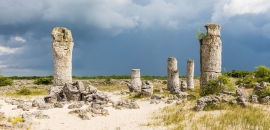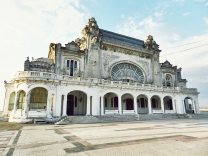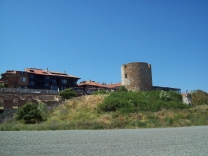No video yet

Kaliakra
Kaliakra (Bulgarian: Калиакра) is a long and narrow headland in the Southern Dobruja region of the northern Bulgarian Black Sea Coast, 12 kilometres (7 mi) east of Kavarna, 60 kilometres (37 mi) northeast of Varna and 65 kilometres (40 mi) southwest of Mangalia. The coast is steep with vertical cliffs reaching 70 metres (230 ft) down to the sea. Kaliakra is a nature reserve, where dolphins and cormorants can be observed. It sits on the Via Pontica, a major bird migration route from Africa into Eastern and Northern Europe. Many rare and migrant birds can be seen here in spring and autumn and, like much of this coastline, is home to several rare breeding birds (e.g. pied wheatear and a local race of European shag). The rest of the reserve also has unusual breeding birds; saker falcon, lesser grey shrike and a host of others.
It also features the remnants of the fortified walls, water-main, baths and residence of Despot Dobrotitsa in the short-lived Principality of Karvuna's medieval capital. The Bolata Cove with a small sheltered beach lies just north at the mouth of a picturesque canyon, also part of the nature reserve.
Name and history
The following names have been used for the headland and the fortress throughout their history:
Thracian: Tirizis (Greek: Τίριζις) Latin: T(i)rissa Greek: Ἂκραι or Καλή Άκρα, Akrai or Kalē Akra Bulgarian: Нос Калиакра Italian: Capo Caliacra Turkish: Kaligra Burnu Romanian: CaliacraThe name "Kaliakra" is of Byzantine Greek origin. It is a combination of "καλός" ("beautiful") and "άκρα" ("headland" or "fortress") and is traditionally translated as "Beautiful Headland".
Kaliakra was the site of the naval Battle of Cape Kaliakra on 11 August 1791, part of the Russo-Turkish War (1787–1792).
The first modern lighthouse on Kaliakra was built in 1866 by the...










